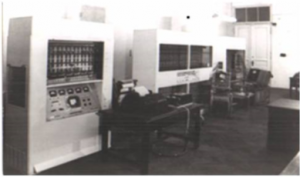M-3 computer
The first domestic vacuum tube computer, the M-3, was built based on Soviet designs. Work began in 1957 at the Hungarian Academy of Sciences' Computer Science and Engineering Department, during which the machine was redesigned using domestic components and several external devices were added, including the original, later self-developed magnetic drum (M-3 drum magazines ).
Sample-based in-house development based on Soviet documentation
The 8-member group included several mechanical designers and technicians (See MTA KKCS )
Use
The machine was primarily designed to perform technical scientific calculations; accordingly, it was suitable
- for integrating ordinary and partial differential equations (also in the nonlinear case)
- for solving multivariable algebraic and transcendental equations
- for performing linear programming tasks
Hungarian Academy of Sciences Computer Center, Budapest (1958-1965)
József Attila University ( JATE ) Cybernetics Laboratory, Szeged (1965-1968)
Structure
Central unit
Word-organizing machine: 31 bpW
- control unit:
- two-address instruction system
- 4 registers (accumulator, index register, instruction counter, selection (preselect) register)
- main store:
- initially one 1 kW, then two magnetic drum magazines, each with a capacity of 1.6 kW (the expansion and the fitting of the second drum are in-house development)
- later 1 KW ferrite ring RAM
- calculator: no
Periphery
- backup storage: magnetic tape, 80 kW (own development)
- external devices:
- originally a 5-lane, 50 chps Teletype typewriter (functions: control console, data entry and result output, simultaneously punching punched tape)
- later 8-track Creed punched tape reader
- 8-band Creed punch (both are custom-made)
The machine was located in 3 cabinets:
- the central cabinet housed the control unit, the calculator and the control panel
- a separate cabinet was occupied by the magnetic drum that served as the main storage and the control system for the other external devices
- the third cabinet contained the power supplies
On a separate table were the punched tape external devices.
Operation
The machine word could contain a two-address instruction or a signed fixed-point binary number; the instruction set consisted of 40 arithmetic/logic and 11 control instructions.
Data was written to and read back from the magnetic drum main storage via 8 read/write head units.
Operation speed:
- with magnetic drum main magazine 50 ips
- with ferrite core 3000 ips
The vacuum tubes failed frequently (on average 20 times per day), resulting in an average mean time between failures (MTBF) of ∼ 3-4 hours.
Program set
- there was no operating system
- compiler:
- assembler-like Symbolic Address Translator, for compiling and running programs written in machine code (own development)
In the early days of computer use in Hungary, numerous application programs were created; some examples are:
- János Balatoni: Design of optical systems
- Tamás Frey– János Szelezsán: Calculations related to the stiffening girders of the Erzsébet Bridge (30×30 nonlinear equation system)
- Gergely József: Calculation of industrial finned heat exchangers
- Béla Krekó– Bálint Dömölki: Minimizing transportation costs
- Pál Rózsa– László Veidinger: Investigation of the behavior of particles in emulsions (inverting 20×20 matrices)
- Ferenc Sándor: Winding calculations (dynamos, transformers)
- János Szelezsán: Partial oxidation of methane (solution of a nonlinear system of equations)
Dr. János Szelezsán reports in detail on the programming work of the M-3 in his study entitled: The first domestic computer applications on the M-3 computer.pdf, which also contains a complete list.
Historical curiosities
The machine consisted of a total of 770 vacuum tubes and 2,000 cupro diodes, organized into nearly 500 sub-units, and occupied an area of about 30 m²; its cooling caused a serious problem due to its consumption of 10 kW.
To eliminate mains voltage fluctuations, the power supply was provided by a motor generator.
Four drum memories could (should) be connected to the machine.
A separate “subunit tester” device was used for troubleshooting and testing.
The first Hungarian “computer music” was also played on the M-3 machine, thanks to a hardware addition developed by the company. Each program had a characteristic music that its programmer already knew well; for example, the “music” of diagnostic programs could be used to determine whether the machine was working properly or incorrectly – if one had a good ear.
The machine was dismantled at the end of its operation in Szeged, and its parts were used for other purposes; more details:
M-3 drum memory (video).
As the first Hungarian-developed electronic computer, it played an important role in the domestic dissemination of computer culture. The employees of the MTA KKCS later became defining figures in domestic computer developments and applications.
The winding story of the "birth" of the M-3 was summarized by Bálint Dömölki and János Szelezsán: A Sziget, pages 97-113.
The history of the development was immortalized by Győző Kovács.
Resources
Overview: M-3
For the design/development collective, see MTA KKCS.
Debugging M-3 programs – a throwback to the KKCs days around 1962
Created: 2015.12.26. 19:56
Last modified: 2025.02.27. 16:04

